
4201 Wingren
Drive, Suite 112 Irving, Texas 75062
972.541.0818 FAX: 972.541.1759
www.jackdial.com





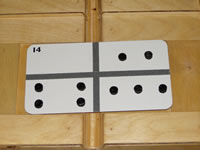


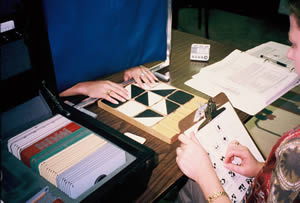
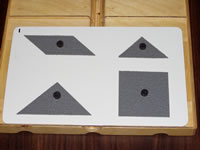

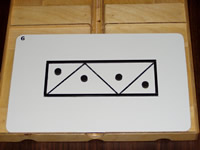

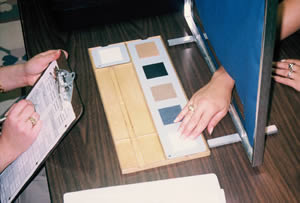
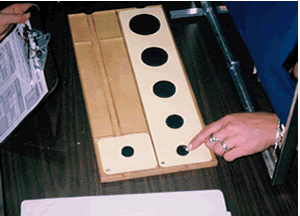
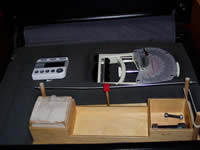
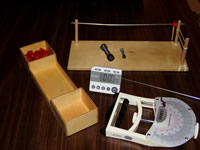
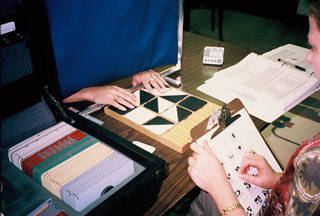


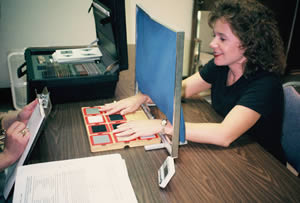
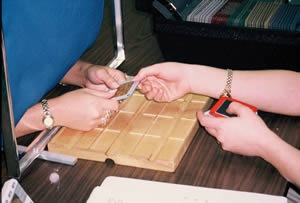
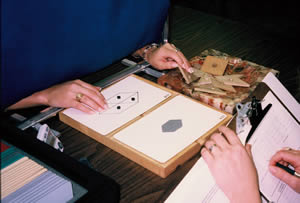
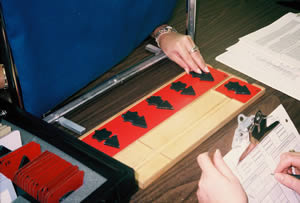



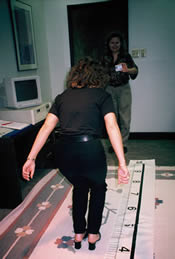
Note: Shoes with high heels should
be removed before administering the jumping subtest.



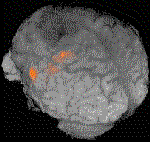 |
 |
The Comprehensive Vocational Evaluation System
for Individuals with Visual Impairment/Blindness (CVES)
Development and Background InformationThe Comprehensive Vocational Evaluation System (CVES) was developed
for use with persons with visual impairment/blindness with support from the
Texas Commission for the Blind. The CVES is a neuropsychologically-based
system designed to assess vocational functioning of persons unable to
be administered traditional instrumentation requiring vision. View a sample report.In addition to describing and predicting the person's vocational potential,
the system provides valuable information useful in developing individual
rehabilitation and educational program plans. The CVES may also be
used in neuropsychological assessment with persons for whom visual
functioning level may affect test performance. The CVES measures
essential verbal-spatial-cognitive, sensorimotor, and emotional-
coping abilities based on a model of evaluation described by McCarron
and Dial. The McCarron-Dial System (MDS) is the most extensively
researched of the existing vocational evaluation systems.The Comprehensive Vocational Evaluation System for Individuals with Visual
Impairment/Blindness (CVES) includes assessment of three major constructs
of behavior: Verbal-Spatial-Cognitive, Sensorimotor, and Emotional-Coping
that are further divided into five "factors" for organizational purposes. Data from
these factors are used to describe individual abilities, skills and aptitudes and
to predict vocational and residential program levels (criteria). Each of these
factors is operationally defined by one or more tests or behavioral instruments. References.
CVES Factors Instruments Verbal-Spatial-Cognitive Wechsler Adult Intelligence Scale - IV (WAIS-IV) Cognitive Test for the Blind (CTB) Wide Range of Achievement Test - 3 (WRAT-3) {supplemental} Woodcock Johnson Psychoeducational Battery {supplemental} Sensory Haptic Sensory Discrimination Test (HSDT) Haptic Memory Matching Test (HMMT) {may be used instead of HSDT) Seashore Rhythm Test (SRT) {supplemental} Speech Sounds Perception Test (SSPT) {supplemental} Motor McCarron Assessment of Neuromuscular Development for Individuals with Visual Impairment/Blindness (MAND-VI)
Emotional Emotional Behavioral Checklist (EBC) Observational Emotional Inventory - Revised (OEI-R) Minnesota Multphasic Personality Inventory - Revised (MMPI-2) {supplemental} Sixteen Personality Factors (16 PF) {supplemental} Rotter Incomplete Sentence Blanks (RISB) {supplemental} Integration-Coping Survey of Functional Adaptive Behavior (SFAB)
Norms - The CVES battery of assessment instruments and procedures
was normed on a group of 1,1000 persons with visual impairment/blindness.
The actual vocational and residential placement levels for each individual
included in this group were determined using the following classifications:
Educational Settings Rehabilitation Settings Residential Settings Basic Skills Daycare/Day Activity Total Care Basic Prevocational Training Work Activities Intermediate Care Advanced Prevocational Training Extended Training Group Home Vocational Readiness Transitional Training Halfway House Vocational Education Community Employment Community Living
Verbal-Spatial-Cognitive Factor (VSC)The VSC factor is defined as the individual's ability to use language, to process
verbal and spatial information and to learn. This factor relates to the person's
attention, perception, association, storage and retrieval of verbal and spatial
information. In general, an individual's performance on the VSC factor may
describe functional language level, academic level, thinking ability, etc.
Performance on this factor may be predictive of future academic attainment,
learning ability, learning style and response to vocational training. Poor
performance on certain VSC tests may also be diagnostic of specific neuro-
psychological conditions such as brain damage, learning disabilities,
mental retardation, etc.The instruments selected to assess this factor, for both vocational and neuro-
psychological evaluation, include the WAIS-IV and CTB. The Verbal IQ
from the WAIS-IV and the Total, Verbal and Performance standard scores
from the CTB are utilized by the EPARS [Evaluation Profile Analysis and
Reporting System] software to construct the Individual Evaluation Profile (EPARS).
In addition, the six CTB factor scores are interpreted by EPARS. View an EPARS report.Cognitive Test for the Blind (CTB): The CTB is the primary CVES measure of cognitive,
intellectual and information processing skills. It differs from the WAIS-IV in that it focuses
on active problem solving, learning and memory. The CTB consists of a Verbal scale
and a non-visual Performance scale from which a Total standard score is derived
(mean = 100; standard deviation = 15). Test-retest reliability of the Verbal scales
revealed a correlation of .96.
There are six verbal subtests from which a Verbal standard score is derived. They include:
Auditory Analysis
The subject is asked to repeat word-like sounds presented by audiotape. This test
requires attention, auditory detection, acoustic analysis and basic expressive language
abilities. The Auditory Analysis subtest was found to be reasonably reliable (test-retest
reliability = .90; interrater reliability = .85).
Immediate Digit RecallThe individual is asked to repeat a series of numbers presented by audiotape.
This test requires attention, concentration, recognition of basic numbers and immediate
memory recall (test-retest reliability was found to be .93). This test is analogous to the
digit series subtest on the WAIS-IV.
Language Comprehension & MemoryStories are presented orally or by audio recording, followed by content-related questions. This
subtest requires receptive language, memory for verbal detail and basic expressive
language. The Language comprehension subtest revealed a test-retest reliability
coefficient of .92. This subtest measures verbal contextual memory and is a good
predictor of an individual's ability to learn verbal information in a traditional classroom
environment.
Letter-Number LearningPaired letters and numbers are presented in series. The individual is asked to
repeat each series presented. Repeated trials (1 to 5) are given until a given
series is correctly recalled. Adequate arousal, attention and concentration also
play a role in the performance of this task. This subtest measures rote verbal
learning abilities. An alternate form of this subtest was used as a method of
estimating reliability. The resulting correlation between the two forms was .90.Vocabulary
The individual is asked to define words orally. This test requires word knowledge,
long-term memory and expressive language functions. Long term verbal memory
and receptive language functions are particularly important. A correlation of .90
between the two forms of this subtest would suggest adequate reliability.Abstract Reasoning (under development)
The individual is verbally presented problems which require both verbal and spatial
mediation. This subtest involves verbal problem solving, concept formation,
mathematical ability, the ability to generalize principles, and the ability to understand
abstract proverbs. Reliability of this subtest has not yet been determined.There are five non-visual performing Performance subtests from which a Performance
standard score is derived. As with the verbal scales,each subtest generates a
raw score from which a scaled score is derived. The CTB Performance section
reveals a test-retest reliability coefficient of .93.These include:
Haptic Category Learning
This subtest is analogous to the Halstead Category Test. The individual is asked to
feel stimuli and is told that what he is feeling should remind him of a number between
one and four. Feedback is given verbally (correct/incorrect). The subject tries to
determine the principle involved in solving the problem. This test
measures non-verbal/spatial concept learning. Abstract spatial reasoning and learning
are involved. The Haptic Category Learning subtest is reasonably reliable, revealing
a coefficient of .85 using the Spearman-Brown prophecy formula for estimating
internal consistency.
Category Memory
The individual is presented a selected number of Haptic Category items (previously
administered) and an equal number of distractor items. He or she is asked to respond
with a "yes" or "no" as to whether he or she has felt the items before. This is a non-verbal
test of incidental memory. The Spearman-Brown method of estimating internal consistency
revealed a reliability coefficient of .86.
Haptic Memory Recognition
Various textures (mounted on Formica tiles) are presented. The individual is
asked to remember the textures. Stimulus items are then mixed with an equal
number of distractors. The subject must identify true positives and true negatives.
This subtest measures immediate tactile (non-verbal) memory. Test-retest reliability
of this subtest revealed a coefficient of .88.
Pattern Recall
Various textured patterns are presented. The individual is asked to remember
the patterns. Stimulus items are removed and shuffled. The subject has to recreate
the pattern from memory. The alternate form reliability of the Pattern Recall subtest was .94.
Spatial Analysis
The individual matches shapes and assembles patterns or configurations
using wooden shapes and tactile frames for reference. This subtest measures complex
spatial analysis and orientation. Test-retest reliability of the Spatial Analysis subtest
was found to be .92.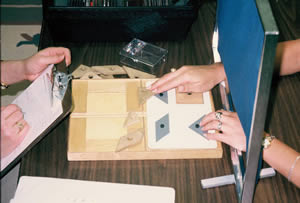
The Wide Range Achievement Test - (WRAT-3)
The WRAT-3 measures reading recognition, spelling and arithmetic. This instrument has been modified for use with individuals with visual impairment/blindness. Norms for Braille reading recognition, large print reading recognition, oral spelling, oral arithmetic and large print arithmetic are available.
Haptic Sensory Discrimination Test (HSDT)
The HSDT is administered routinely in the CVES to assess the Sensory
factor. The HSDT is used in assessing tactile-matching skills, short-term haptic
memory and spatial localization skills in the visually-impaired/blind population.
Tactile discrimination involves the manipulation of objects in the hand to discriminate
their particular shape, size, texture and spatial arrangement and to conceptually
integrate these sensations to form an accurate mental representation of the
total object. Geometrically shaped and textured objects are obscured from the
visual field and manipulated in one hand. The individual is asked to remember
what is felt and to locate an identical object with the same hand from among
various choices. Initial Studies of the reliability of the HSDT reveal relatively
high results (r = 92). Tactile-memory performance on both sides of the body
correlates to educational and vocational potential.
McCarron Assessment of Neuromuscular Development for
persons with Visual Impairment (MAND-VI)
The primary CVES measure used to assess the Motor factor in
vocational, educational and clinical neuropsychological assessment
in the McCarron Assessment of Neuromuscular Development for
individuals with Visual Impairment/Blindness. The MAND-VI consists of
five fine and five gross motor tests combined to produce a total
motor score.
The MAND-VI has demonstrated reliability (test-retest
correlation of .99)) for disability groups. The predictive validity between
the MAND-VI and work performance is significant (r = .71; p< .001).
The correlation coefficient between the MAND-VI and residential
program level is also significant (r = .50; p < .001).The MAND-VI provides a comprehensive assessment of the
individual's neuromuscular functioning. Factors measured include:
Persistent Control - the integration of perceptual skills with the
regulation of hand-arm movement. The tasks require controlled
hand-arm coordination, the ability to focus attention while inhibiting
extraneous motor movements, and the adequate integration of
proprioceptive feedback. Inadequate persistent control may also
suggest poorly focused attention.
Muscle Power - The tasks include a measure of hand/arm strength
and a measure of leg strength. In children, poor muscle power may
interfere with recreational activities and participation in sports, thusNote: Shoes with high heels should
be removed before administering the g heel-toe-walk subtest.leading to secondary social/emotional problems. Vocationally,
depressed muscle power may interfere with tasks that require lifting,
carrying, pushing or pulling. In clinical assessment, reduced
muscle power, particularly to the upper body, may indicate cortical
level brain damage.
Kinesthetic Integration - This factor is defined as the control of
balance and orientation of the body in space. Performance
on these subtests involves static balance and equilibrium as
well as dynamic balance with the integration of sensorimotor
input from large muscle systems.
Bimanual Dexterity - This factor requires integration of
proprioceptive and kinesthetic information with fine motor
coordination of both hands. Deficits in bimanual dexterity have
a negative impact on a wide range of daily living and work activities.In addition to the four factors listed above, specific MAND-VI
scores related to speed, strength and fine motor coordination
are combined to form a Hand Preference Index (HPI) for both
the right and left sides of the body as well as a measure of hand
fatigue.
Observational Emotional Inventory (OEI-R or OEI)
The Emotional Factor is measured by the OEI-R or the EBC (see
below). The OEI-R provides a structure for observing and rating overt
emotional behaviors which interfere with educational or vocational
potential. The OEI-R is a situational assessment of the individual's
behavior in a school or work setting. The OEI-R appears to be
sufficiently reliable (.96) and valid to identify problem behaviors in
need of remediation. The seven factors are: Impulsivity-Frustration,
Anxiety, Depression-Withdrawal, Socialization, Self-Concept,
Aggression, and Reality Disorientation.
Emotional Behavioral Checklist (EBC)
The EBC is a scale designed to assess the same factors of emotional
behavior included in the OEI-R (Impulsivity-Frustration, Anxiety,
Depression-Withdrawal, Socialization, Self-Concept, Aggression,
and Reality Disorientation). This instrument is highly correlated
with the OEI-R (r = .92), but is a shorter form and does not require
an extensive observation period. The EBC can be used in clinical and
school settings as well as in rehabilitation facilities.
Survey of Functional Adaptive Behaviors (SFAB)
The Integration-Coping factor is measured by the SFAB. Integration-
Coping is defined as the individual's knowledge and skills related
to activities of daily living, personal-social, and work adjustment.
As such, it is a global factor which encompasses many aspects of
functional adaptive behavior. The SFAB can be completed from
history and interview but has increased reliability and validity when
opportunities for extended behavioral observation are available.
The SFAB also has further utility for developing individual program
plans in public school or rehabilitation settings.The SFAB is a comprehensive rating scale of adaptive behavior.
It includes 135 specific behavioral items covering four major
skill areas: Residential Living Skills; Daily Living Skills; Academic
Skills; and Vocational Skills.Each of the major skill areas is further subdivided into the following:
Personal Management; Home Management; Functional Skills;
Community Services; Travel Skills; Numerical Reasoning and
Mathematics; Functional Language, Literacy and Writing;
Physical Abilities; and Vocational Behaviors.PM - This section includes 15 items relating to basic self-care
and hygiene, dressing and grooming, and personal health care and safety.HM - This section includes 15 items relating to clothing care,
general household duties, kitchen and food preparation.FS - This area includes 20 items relating to money, financial
management, time orientation and management, and use of the
telephone.CS- This section includes 10 items associated with knowledge
and access of public services and social/recreational resources.TS - This area assesses 10 behaviors required in successful
orientation and mobility.NRM- This section includes 10 items relating to numerical reasoning,
mathematics and weights and measures.FL- This area includes 10 items to assess receptive and expressive
language.VB- This section includes 20 items descriptive of work adjustment.
Report Development
Upon completion of administering the CVES, scores are entered
into the EPARS computer interpretive program to generate a detailed
evaluation report. The EPARS report can be further customized and
individualized using common word processing programs. Narrative
information, vocational interest tests, work personality traits, transferable
skills analysis, recommended vocational considerations, etc. may be
added to the EPARS report. The report predicts an individual's vocational
and residential program levels. View a sample EPARS report.
Purchasing the CVES
The CVES is available for purchase from McCarron-Dial Systems. McCarron-Dial
Systems is a separate business entity and is the test publisher. Contact them
for purchasing test instrumentation, software, manuals, protocols, etc.